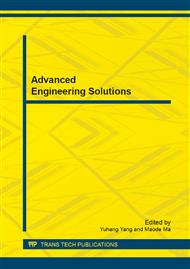[1]
M.S. El-Bourawi, M. Khayet, R. Ma, Z. Ding, Z. Li and X. Zhang. Membrane Science Vol. 301 (2007), pp.200-209.
DOI: 10.1016/j.memsci.2007.06.021
Google Scholar
[2]
Q. Du, S.J. Liu, Z.H. Cao and Y.Q. Wang. Separation and Purification Technology Vol. 44 (2005), pp.229-234.
Google Scholar
[3]
S.N. Ashrafizadeh and Z. Khorasani. Chemical Engineering Journal Vol. 162 (2010), pp.242-249.
Google Scholar
[4]
G. Ruiz, D. Jeison and R. Chamy. Water Resarch. Vol. 37 (2003), pp.1371-1377.
Google Scholar
[5]
Z. Zhu, Z. Hao, Z. Shen and J. Chen. Journal of Membrane Science Vol. 250 (2005), pp.269-276.
Google Scholar
[6]
Z. Xie, T. Duong, M. Hoang, C. Nguyen and B. Brian. Water Research Vol. 43 (2009), pp.1693-1699.
Google Scholar
[7]
R.S. Juang, S.H. Lin and M.C. Yang. Journal of Membrane Science Vol. 255 (2005), pp.79-87.
Google Scholar
[8]
G. Lewandowicz, W. Bialas, B. Marczewski and D. Szymanowska. Journal of Membrane Science Vol. 375 (2011), pp.211-219.
Google Scholar
[9]
K.W. Lawson and D.R. Lloyd. Membrane Science Vol. 124 (1997), pp.1-25.
Google Scholar
[10]
M.S. El-Bourawi, Z. Ding, R. Ma and M. Khayet. Journal of Membrane Science Vol. 285 (2006), pp.4-29.
Google Scholar
[11]
Z.W. Ding, L.L. Liu, Z.M. Li, R.Y. Ma and Z.R. Yang. Journal of Membrane Science Vol. 286 (2006), pp.93-103.
Google Scholar
[12]
J.J. Tang, K.G. Zhou, Q.X. Zhang and R.J. Ma. Mining and Metallurgical Engineering Vol. 22 (2002), pp.73-76.
Google Scholar
[13]
E.A. Mason and A.P. Malinauskas. Gas Transport in PorousMedia: The Dusty Gas Model. (Elsevier, New York 1983).
Google Scholar
[14]
R. Sedlack. Phosphorus and nitrogen removal from municipal wastewater: principles and practice (Lewis publishers, New York 1991).
Google Scholar
[15]
J.P. Mericq, S. Laborie and C. Cabassud. Water Research Vol. 44 (2010), pp.5260-5273.
Google Scholar
[16]
R.H. Perry and D.W. Green. Perry's Chemical Engineers' Handbook (McGraw Hill International Editions1997).
Google Scholar
[17]
J. Dewulf, D. Drijvers and H.V. Langenhove. Atmospheric Environment Vol. 29 (1995), pp.323-331.
Google Scholar
[18]
R. Sing, B. Rumpf and G. Maurer. Industrial & Engineering Chemistry Research Vol. 38 (1999), pp.2098-2109.
Google Scholar
[19]
B. Rumpf and G. Maurer. Industrial & Engineering Chemistry Research Vol. 32 (1993), pp.1780-1789.
Google Scholar


